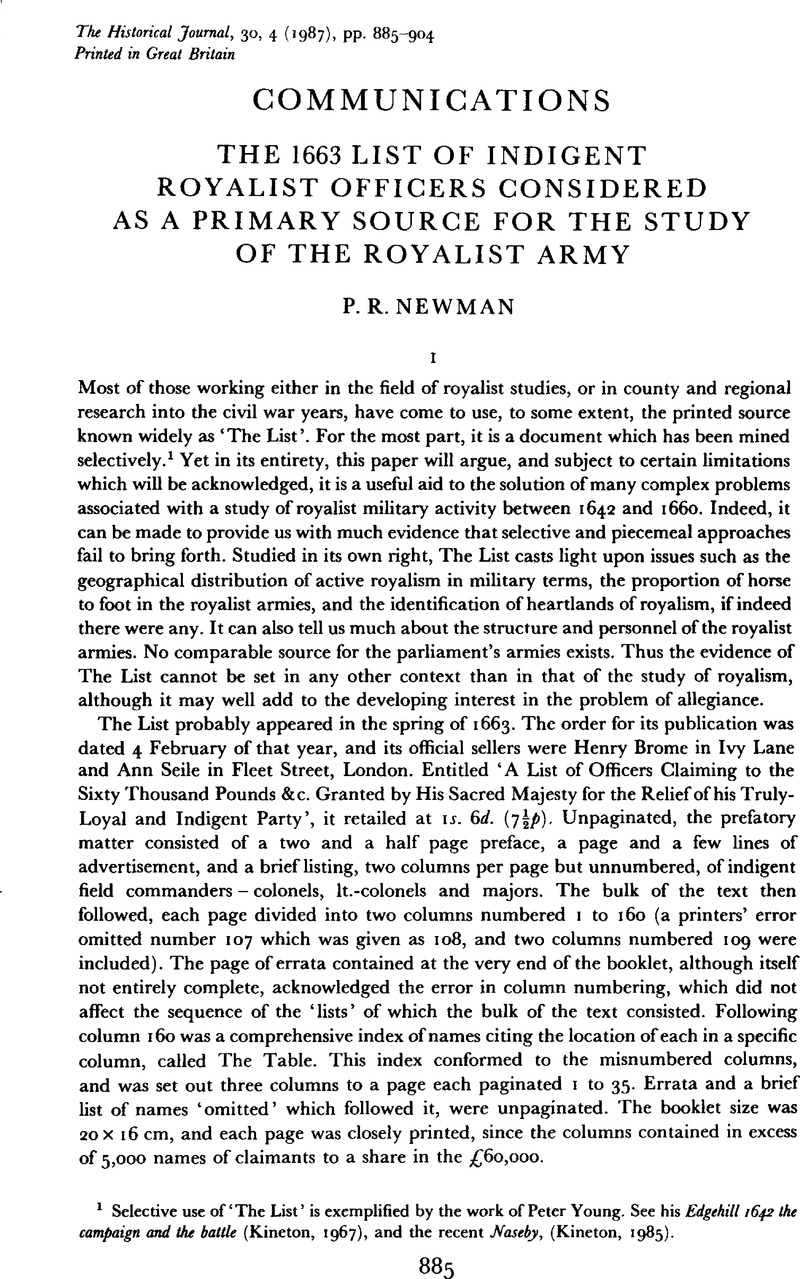Article contents
The 1663 List of Indigent Royalist Officers considered as a Primary Source for the Study of the Royalist Army
Published online by Cambridge University Press: 11 February 2009
Abstract

- Type
- Communications
- Information
- Copyright
- Copyright © Cambridge University Press 1987
References
1 Selective use of ‘The List’ is exemplified by the work of Young, Peter. See his Edgehill 1642 the campaign and the battle (Kineton, 1967)Google Scholar, and the recent Naseby, (Kineton, 1985)Google Scholar.
2 The Calendars of State Papers Domestic Senes for the Restoration period were consulted extensively for my Royalist officers in England and Wales 1642–1660 a biographical dictionary (New York, 1981)Google Scholar
3 Quarter Sessions Records are rarely available in published form For the use of them, see Underdown, David, Revel, not and rebellion (Oxford, 1985)Google Scholar
4 Newman, Royalist officers, passim
5 Newman, P R, ‘The Royalist officer corps 1642–1660 army command as a reflexion of the social structure’, Historical Journal, xxvi (1983), 945–58Google Scholar Also, Newman, Royalist officers
6 14 Car. 11 c8, Statutes of the realm, 1963 repr., v, 380–4.
7 Newman, P. R., ‘Royalist armies in the north of England 1642–5’, unpublished D.Phil, thesis, University of York, 1978Google Scholar.
8 Brandling's case is a classic example of a royalist officer turned parliamentarian whose subsequent service led to the waiving of all proceedings against him in respect of earlier delinquency. See Newman, , Royalist officers, pp. 40–1 and sources there citedGoogle Scholar.
9 Underdown, Revel, riot and rebellion, especially chapters 6 and 7.
10 Malcolm, Joyce, Caesar's due: loyalty and King Charles 1642–46, (London, 1983)Google Scholar, chapter 4, and her article, ‘A king in search of soldiers: Charles I in 1642’, Historical Journal, XXI (1978), 251–74Google Scholar
11 Newman, ‘Royalist officer corps’, passim.
12 Newman, ‘Royalist officer corps’, passim.
13 Examples of familial connexion between officers in the same regiment are numerous in my Royalist officers For example, p 4, James Apsley, It colonel to his brother Allen, p 23 James Belhngham It colonel to his father Sir Henry, p 34 Robert Bodenham major to his brother Colonel Wingfield Bodenham, p 47 Thomas Bulkeley's questionable commission to his son Colonel Richard Bulkeley, p 49, Sebastian Boncle captain then major under his brother George, p 305, Captain Thomas Gower left the regiment raised by his father Colonel Sir Thomas Gower, to become major of foot under Lord Eythm
14 The military situation in Cumberland and Westmoreland is covered extensively in Newman, ‘Royalist armies’.
15 A striking case of this is that of Colonel William Smith of Buckingham, whose newly formed foot regiment was broken up at Hillesden House in Buckinghamshire in March 1644, barely three months after his commission was granted. See Newman, , Royalist officers, p. 349Google Scholar and sources there cited.
- 4
- Cited by


